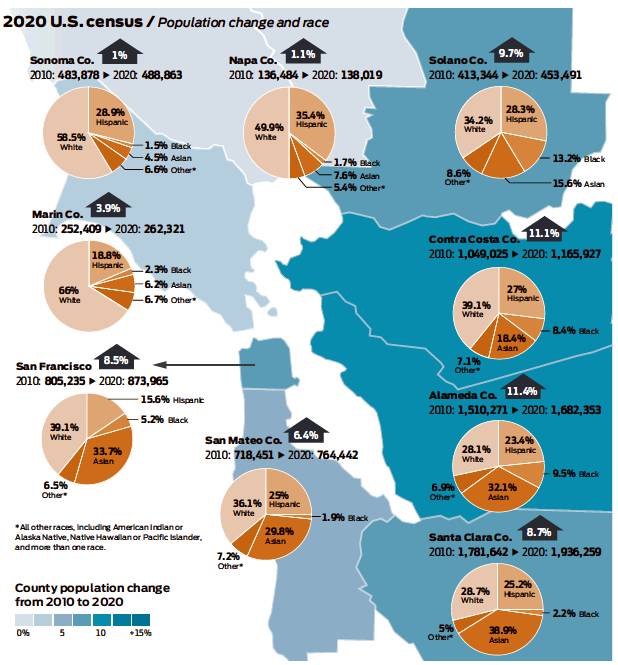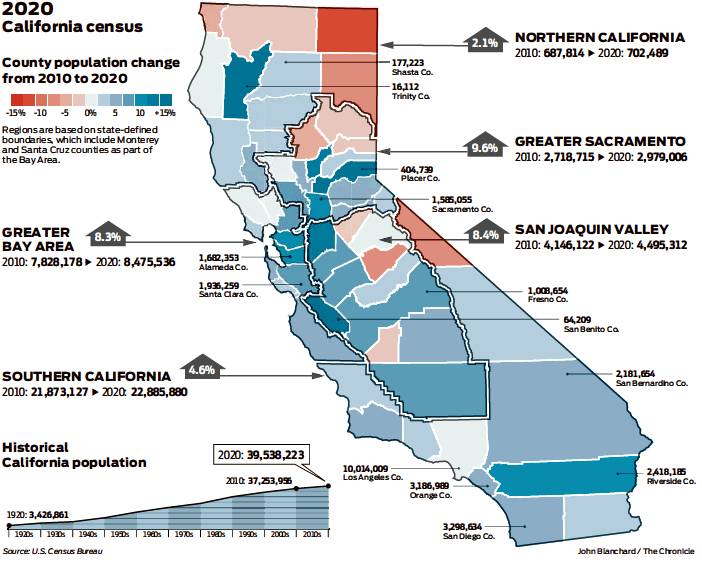Bay Area outpaces state in population increase
2020 census: 8.6% rise includes major growth among Asians, Hispanics
By Roland Li and Nami Sumida
The Bay Area’s population growth outpaced both California and the U.S. over the past decade, with big gains for Asian, Latino and Hispanic groups, according to U.S. Census Bureau data released Thursday on the results of the 2020 decennial census.
From 2010 to 2020, the nine-county region added 614,901 residents amid a tech boom, an 8.6% increase that surpassed California’s growth rate of 6.1% and the U.S. rate of 7.4%, according to a Chronicle analysis. The Greater Bay Area, including Monterey and Santa Cruz counties, grew by 8.3%.
The Bay Area had a record high 7.77 million people last year. California had 39.5 million people. The data represents the number of people living in these areas on April 1, 2020.
The share of the white population fell in all nine Bay Area counties, mirroring national trends, with the largest drop in Contra Costa County from 47.8% to 39.1%.
Nationally, the share of the white population fell from 63.7% in 2010 to 57.8% last year, the lowest on record. Latinos and Hispanics became the largest ethnic group in California for the first time at 39.4% of the population, up from 37.6% in 2010. The share of white people who do not identify as Hispanic dropped from 40.1% to 34.7% in the state. Asians now make up 15.1% of the state, the second-highest share among states behind Hawaii.
“Our analysis of the 2020 census results show that the U.S. population is much more multiracial, and more racially and ethnically diverse than what we measured in the past,” said Nicholas Jones, director of race and ethnicity outreach for the Census Bureau’s population division.
The trends could fuel more calls for diversity among elected officials, and the data will inform a contentious Congressional redistricting process that includes California’s first loss of a House seat, as well as federal funding allocations.
“There’s definitely going to be calls for districts that offer better representation,” said Eric McGhee, a senior fellow at the Public Policy Institute of California, a nonprofit research institute.
In the Bay Area, Asians grew their share of the population in all nine counties. Santa Clara County’s Asian population jumped to 38.9% from 31.7% in 2010, the biggest gain, followed by Alameda County’s 6.2-percentage-point gain and San Mateo County’s 5.3-percentage-point increase.
The share of Latinos and Hispanics grew in seven of nine Bay Area counties, with a 4.3-percentage-point gain in Solano County as the region’s largest.
San Francisco saw the smallest drop of its white population among Bay Area counties at 2.8 percentage points, while the share of people of two races or more grew from 3% to 5%. The city saw other ethnic population shifts under 1 percentage point, making it the county that changed the least demographically in the past decade.
Eight Bay Area counties saw Black residents’ share of the population decline, with Alameda County seeing the biggest drop, at 2.7 percentage points. Other counties had losses of 1 percentage point or less, while Sonoma County’s Black population share was up slightly, at 0.1 percentage points.
Alameda County had the Bay Area’s largest population increase, 11.4%, followed by neighboring Contra Costa County at 11.1% and Solano County at 9.7%.
Sonoma County had the lowest population growth at 1% and Napa County at 1.1%. Both areas have been ravaged by wildfires in recent years.
McGhee said the Bay Area’s growth was expected, but it’s unclear how the pandemic will affect the region’s future population trends. Even before the last year, residents were struggling to afford housing and moving to cheaper areas or out of the state.
But the abundance of jobs will continue to draw residents or keep them in the area, he said.
San Francisco “has lost some people, but a lot of people it lost have gone across the bay,” he said. U.S. Postal Service data showed the majority of Bay Area residents who moved last year stayed within the region and state.
On the state level, a lower birth rate, residents leaving and less international immigration mean that population growth is expected to slow after turning negative last year, according to state data.
“There’s no doubt that the state is on a trajectory of slower growth for the foreseeable future,” McGhee said.
Two small Northern California counties saw the state’s biggest population swings: Modoc County had the steepest population decline with a loss of 10.2%, while Trinity County had the state’s biggest gain at 16.9%.
Dublin was the fastest-growing city with more than 50,000 people in the Bay Area, with its population surging 57.7% to about 72,600 residents in the past decade. The Tri-Valley suburb has added thousands of units of new housing and attracted residents looking for a cheaper cost of living compared to San Francisco.
The search for housing affordability also led to an influx of residents to the Sacramento region, which saw a 9.6% jump in residents, the highest among the state’s regions, and the San Joaquin Valley, which grew by 8.4%. Southern California grew by 4.6% and the rural parts of Northern California outside of the Bay Area grew by 2.1%.
Roland Li and Nami Sumida are San Francisco Chronicle staff writers.Email: roland.li@sfchronicle.com, nami.sumida@sfchronicle.com Twitter: @rolandlisf @namisumida
331,449,281
U.S. population a 7.4% increase from 2010
39,538,223
California population a 6.1% increase from 2010
7,765,640
Bay Area population an 8.6% increase from 2010

